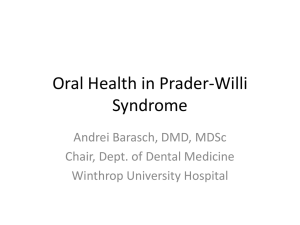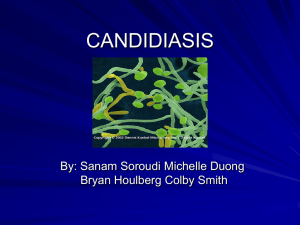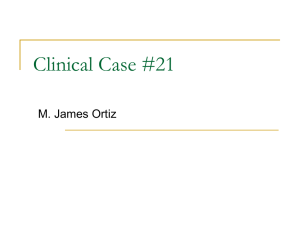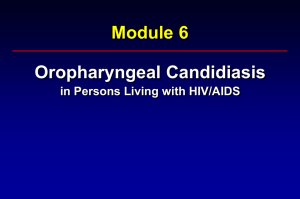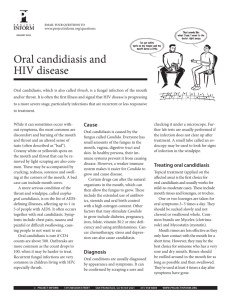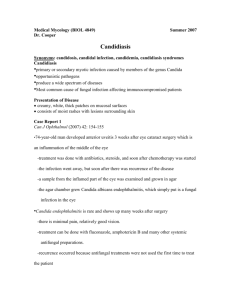Asian Journal of Medical Sciences 3(2): 52-55, 2011 ISSN: 2040-8773
advertisement
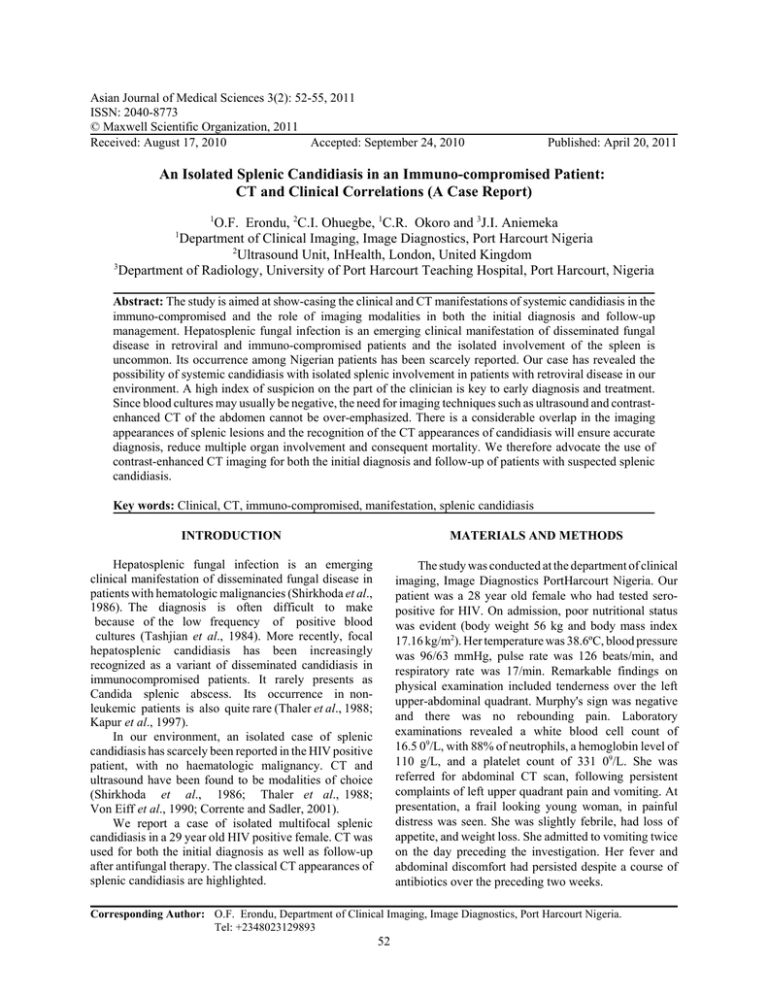
Asian Journal of Medical Sciences 3(2): 52-55, 2011 ISSN: 2040-8773 © Maxwell Scientific Organization, 2011 Received: August 17, 2010 Accepted: September 24, 2010 Published: April 20, 2011 An Isolated Splenic Candidiasis in an Immuno-compromised Patient: CT and Clinical Correlations (A Case Report) 1 O.F. Erondu, 2C.I. Ohuegbe, 1C.R. Okoro and 3J.I. Aniemeka Department of Clinical Imaging, Image Diagnostics, Port Harcourt Nigeria 2 Ultrasound Unit, InHealth, London, United Kingdom 3 Department of Radiology, University of Port Harcourt Teaching Hospital, Port Harcourt, Nigeria 1 Abstract: The study is aimed at show-casing the clinical and CT manifestations of systemic candidiasis in the immuno-compromised and the role of imaging modalities in both the initial diagnosis and follow-up management. Hepatosplenic fungal infection is an emerging clinical manifestation of disseminated fungal disease in retroviral and immuno-compromised patients and the isolated involvement of the spleen is uncommon. Its occurrence among Nigerian patients has been scarcely reported. Our case has revealed the possibility of systemic candidiasis with isolated splenic involvement in patients with retroviral disease in our environment. A high index of suspicion on the part of the clinician is key to early diagnosis and treatment. Since blood cultures may usually be negative, the need for imaging techniques such as ultrasound and contrastenhanced CT of the abdomen cannot be over-emphasized. There is a considerable overlap in the imaging appearances of splenic lesions and the recognition of the CT appearances of candidiasis will ensure accurate diagnosis, reduce multiple organ involvement and consequent mortality. We therefore advocate the use of contrast-enhanced CT imaging for both the initial diagnosis and follow-up of patients with suspected splenic candidiasis. Key words: Clinical, CT, immuno-compromised, manifestation, splenic candidiasis INTRODUCTION MATERIALS AND METHODS Hepatosplenic fungal infection is an emerging clinical manifestation of disseminated fungal disease in patients with hematologic malignancies (Shirkhoda et al., 1986). The diagnosis is often difficult to make because of the low frequency of positive blood cultures (Tashjian et al., 1984). More recently, focal hepatosplenic candidiasis has been increasingly recognized as a variant of disseminated candidiasis in immunocompromised patients. It rarely presents as Candida splenic abscess. Its occurrence in nonleukemic patients is also quite rare (Thaler et al., 1988; Kapur et al., 1997). In our environment, an isolated case of splenic candidiasis has scarcely been reported in the HIV positive patient, with no haematologic malignancy. CT and ultrasound have been found to be modalities of choice (Shirkhoda et al., 1986; Thaler et al., 1988; Von Eiff et al., 1990; Corrente and Sadler, 2001). We report a case of isolated multifocal splenic candidiasis in a 29 year old HIV positive female. CT was used for both the initial diagnosis as well as follow-up after antifungal therapy. The classical CT appearances of splenic candidiasis are highlighted. The study was conducted at the department of clinical imaging, Image Diagnostics PortHarcourt Nigeria. Our patient was a 28 year old female who had tested seropositive for HIV. On admission, poor nutritional status was evident (body weight 56 kg and body mass index 17.16 kg/m2). Her temperature was 38.6ºC, blood pressure was 96/63 mmHg, pulse rate was 126 beats/min, and respiratory rate was 17/min. Remarkable findings on physical examination included tenderness over the left upper-abdominal quadrant. Murphy's sign was negative and there was no rebounding pain. Laboratory examinations revealed a white blood cell count of 16.5 09/L, with 88% of neutrophils, a hemoglobin level of 110 g/L, and a platelet count of 331 09/L. She was referred for abdominal CT scan, following persistent complaints of left upper quadrant pain and vomiting. At presentation, a frail looking young woman, in painful distress was seen. She was slightly febrile, had loss of appetite, and weight loss. She admitted to vomiting twice on the day preceding the investigation. Her fever and abdominal discomfort had persisted despite a course of antibiotics over the preceding two weeks. Corresponding Author: O.F. Erondu, Department of Clinical Imaging, Image Diagnostics, Port Harcourt Nigeria. Tel: +2348023129893 52 Asian J. Med. Sci., 3(2): 52-55, 2011 We obtained the permission of the Research and Human Ethics committee of Image Diagnostics to reproduce the images and patient’s clinical data. RESULTS AND DISCUSSION A contrast-enhanced abdominal CT scan was done with a single slice helical GE CT/e scanner. Contiguous slices with 3 mm cuts were obtained. Major CT findings include a moderately enlarged spleen with multiple, lowattenuation, non-enhancing lesions with size ranges of 3 to 4.5 mm (Fig. 1). The gallbladder lumen appeared relatively large with thickened walls and minimal oedema. No gallstones or sludges were noted. The liver, pancreas, both kidneys and adrenals were unremarkable. The upper GIT appeared normal showing normal mucosal coating with oral contrast. No lymphadenopathy or ascites was seen. A diagnosis of splenic candidiasis was made. Further laboratory investigations were consequently done. Bile culture tested positive and blood culture tested negative, for Candida albicans. Alkaline phosphatase levels were within normal range. A working diagnosis of splenic candidiasis was made and consequently, patient was treated with anti-fungals, specifically nystatin and ketoconazole and response was remarkable. A follow-up contrast CT scan of the abdomen after two weeks showed significant interval regression of the splenic lesions. Patient was no longer febrile and her appetite was improved (Fig. 2, 3, 4). Hepatosplenic fungal infection is an emerging clinical manifestation of disseminated fungal disease in patients with hematologic malignancies (Von Eiff et al., 1990; Pagano et al., 2002; Yanagisawa et al., 2007; Kim et al., 2009).The reported incidence of fungal dissemination in these patients has ranged from 20%to 40% (De Gregorio et al., 1982). The diagnosis is often difficult to make because of the low frequency of positive blood cultures (Tashjian et al., 1984). Therefore, in the setting of prolonged fever associated with neutropenia, and abdominal pain, systemic fungal disease must be suspected (Gangadharan et al., 2002; Nicholas et al., 2003; Saint-Faust et al., 2009). Effective diagnosis of organ involvement must be based mostly on clinical experience and an aggressive examination of tissue (Tashjian et al., 1984). Computed tomography (CT), MRI and ultrasound are the modalities of choice in the assessment of hepatosplenic fungal abscesses (Pastakia et al., 1988; Sallah 1999; Semelka et al., 1997; Corrente and Sadler, 2001; Saint-Faust et al., 2009). Hepatosplenic candidiasis has increased in frequency among immunocompromised hosts. Despite standardization, reliable data yielding a predictable incidence so far is unavailable (Cantu, 2005). Risk factors include hematologic malignancy, intensive chemotherapy, Fig. 1: Multiple low attenuation lesions in an enlarged spleen Fig. 2: CT appearances after anti-fungal therapy Fig. 3: Follow-up imaging showing reduction in number and size of lesions after treatment prolonged neutropenia, and treatment with broadspectrum antibiotics. Patients most commonly present with abdominal pain, persistent fevers despite antibiotic 53 Asian J. Med. Sci., 3(2): 52-55, 2011 Definitive diagnosis can be established only by biopsy showing evidence of yeasts or pseudohyphae in the granulomatous lesions (Yanagisawa et al., 2007). Cultures are frequently negative, however, especially in patients who have been pretreated with antifungal agents (Thaler et al., 1988; Pappas et al., 2004). CONCLUSION Our case has revealed the possibility of systemic candidiasis with isolated splenic and gallbladder involvement in patients with retroviral disease in our environment. A high index of suspicion on the part of the clinician is key to early diagnosis and treatment. Since blood cultures may usually be negative, the need for imaging techniques such as CT of the abdomen cannot be over-emphasized. Furthermore, the recognition of the CT appearances will ensure accurate diagnosis and reduce multiple organ involvement and consequent mortality. We therefore advocate the use of CT imaging for both the initial diagnosis and follow-up of patients with suspected splenic or hepatic candidiasis. Fig. 4: Follow-up image therapy, and an elevated alkaline phosphatase level that is out of proportion to other hepatic enzyme levels (Gangadharan et al., 2000; Pagano et al., 2002; Ascioglu et al., 2002). This was the case with our patient, although the alkaline phosphatase was performed after the CT scan and was apparently normal. Gastrointestinal mucosal damage secondary to intensive chemotherapy may allow colonization with Candida species and subsequent seeding of the portal vein (Von Eiff et al., 1990; Flannery et al., 1992). A case of gastric candidiasis has been reported as a subepithelial mass in an immunocompromised host (Kim et al., 2009), while small bowel obstruction was reported as a possible complication of GIT involvement (Bielen et al., 2004). Organ involvement may lead to hepatosplenomegaly. The diagnosis of hepatosplenic candidiasis can be made through Ultrasound and/or CT, and MRI investigations of the abdomen which may reveal characteristic lesions in the liver and the spleen (Corrente and Sadler, 2001; Saint-Faust et al., 2009, Semelka et al., 1997). The involvement of gallbladder has not been commonly reported as was noted in our case. During treatment there may be induced neutropenia. The characteristic "bull's eye" lesions and “wheels within wheels” appearance seen on ultrasound and CT (Pastakia et al., 1988; Ascioglu et al., 2002) are not detectable until neutrophil recovery has occurred. After granulocyte recovery these foci show characteristic histological patterns (Von Eiff et al., 1990). There is a substantial overlap in imaging features between different disease entities of the spleen, and recognition of the typical appearances of splenic candidiasis may pose a challenge (Hui et al., 2007). Consequently a close clinical and pathologic correlation in addition to CT scanning is required in the follow-up of hepatosplenic of suspected fungal infections (Shirkhoda et al., 1986; Corrente and Sadler, 2001). ACKNOWLEDGMENT We acknowledge the Data and Ethics committee of Image Diagnostics PH. REFERENCES Ascioglu, S., J.H. Rex, B. de Pauw, J.E. Bennett, J. Bille, F. Crokaert, D.W. Denning, J.P. Donnelly, J.E. Edwards, Z. Erjavec, D. Fiere, O. Lortholary, J. Maertens, J.F. Meis, T.F. Patterson, J. Ritter, D. Selleslag, P.M. Shah, D.A. Stevens and T.J. Walsh, 2002. Defining opportunistic invasive fungal infections in immunocompromised patients with cancer and hematopoietic stem cell transplants: An international consensus. Clin. Infect. Dis., 34(1): 7-14. Bielen, D., K. Mortele, H. Peters, D. Lombard and P. Ros, 2005. Small bowel obstruction secondary to disseminated Candidiasis in an immunocompromised patient. Radiologic and pathologic correlation. J. Belge de Radiologie JBR-BTR, 88(1): 20-22. Cantu, J., 2005. Hepatosplenic candidiasis in patients with acute leukemia. Internet J. Emerg. Intensive Care Med., 8(2). Corrente, L. and M.A. Sadler, 2001. A fungus by another name: Candida glabrata. AJR, 177(3): 721. De Gregorio, M.W., W.M.F. Lee, C.A. Linker, R.A. Jacobs and C.A. Ries, 1982. Fungal infections inpatients with acute leukemia. Am. J. Med., 73: 543-548. 54 Asian J. Med. Sci., 3(2): 52-55, 2011 Flannery, M.T., D.B. Simmons, H. Saba, P. Altus, P.M. Wallach, H.M. Adelman, 1992. Fluconazole in the treatment of hepatosplenic candidiasis. Arch. Intern. Med., 152(2): 406-408. Gangadharan, V.P., K. Sasidharan, S. Preetha and K. Chithrathara, 2002. Chronic systemic (hepatosplenic) candidiasis in a patient with granulocytic sarcoma. Am. J. Clin. Oncol., 23(6): 562-563. Hui, J.P.K., K.M. Kwok, M.H.Y. Lai, T.K.L. Loke, W.H. Luk and J.C.S. Chan, 2007. Splenic candidiasis. JHK Coll. Radiol., 10: 19-22. Kapur, A., A.R. Vasudev and C.W. Howden, 1997. Candida splenic abscess in the absence of obvious immunodeficiency. Am. J. Gastroenterol., 92(3): 509-512. Kim, S.H., S.G. Kim, S.J. Kang, M.N. Kim, J.M. Park, H.J. Jo, M.S. Choi and I.S. Song, 2009. A case of gastric candidiasis presented as subepithelial mass in an immunocompromised host. Korean J. Gastroenterol., 53(1): 43-47. Nicholas, J.E., L. Johnsey and P. Yijun, 2003. Systemic candidiasis. Radiographics, 23: 1287-1290. Pagano, L., L. Mele, L. Fianchi, L. Melillo, B. Martino, D. D'Antonio, M.E. Tosti, B. Posteraro, M. Sanguinetti, G. Trape, F. Equitani, M. Carotenuto and G. Leone, 2002. Chronic disseminated candidiasis in patients with hematologic malignancies. Clinical features and outcome of 29 episodes. Haematologica, 87(5): 535-541. Pappas, P.G., J.H. Rex, J.D. Sobel, S.G. Filler, W.E. Dismukes, T.J. Walsh and J.E. Edwards, 2004. Infectious diseases society of America. Guidelines for treatment of candidiasis. Clin. Infect. Dis., 38(2): 161-189. Pastakia, B., T.H. Shawker, M. Thaler, T. O'Leary and P.A. Pizzo, 1988. Hepatosplenic candidiasis: Wheels within wheels. Radiology, 166(2): 417-421. Sallah, S., 1999. Hepatosplenic candidiasis in patients with acute leukemia: Increasingly encountered complication. Anticancer Res., 19(1B): 757-760. Shirkhoda, A., G. Lopez-Berestein, J.M. Holbert and M.A. Luna, 1986. Hepatosplenic fungal infection: CT and pathologic evaluation after treatment with liposomal amphotericin B. Radiology, 159: 349-353. Saint-Faust, M., C. Boyer, M. Gari-Toussaint, A. Deville, M. Poiree, M. Weintraub and N. Sirvent, 2009. Adjuvant corticosteroid therapy in 2 children with hepatosplenic candidiasis-related IRIS. J. Pediatr. Hematol. Oncol., 10: 794-796. Semelka, R.C., N.L. Kelekis, S. Sallah, S. Worawattanakul and S.M. Ascher, 1997. Hepatosplenic fungal disease: Diagnostic accuracy and spectrum of appearances on MR imaging. AJR, 169(5): 1311-1316. Tashjian, L.S., J.S. Abramson and J.E. Peacock, 1984. Focal hepatic candidiasis: a distinct clinical variant of candidiasis in immunocompromised patients. Rev. Infect. Dis., 6: 689-703. Thaler, M., B. Pastakia, H. Thomas, T. O’leary and Pizzoshawker, 1988. Hepatic Candidiasis in Cancer Patients: The Evolving Picture of the Syndrome. Ann. Intern. Med., 108(1): 88-100. Von Eiff, M., M. Essink, N. Roos, W. Hiddemann, T.H. Büchner and J. Van de Loo, 1990. Hepatosplenic candidiasis, a late manifestation of Candida septicaemia in neutropenic patients with haematologic malignancies. Ann. Hematol., 60(4): 215-260. Yanagisawa, N., A. Suganuma, N. Takeshita, A. Imamura, A. Ajisawa, M. Negishi, T. Suzuki and M. Honma, 2007. A case of disseminated candidiasis as an initial presentation of AIDS (Japanese). Kansenshogaku Zasshi, 81(4): 459-462. 55
